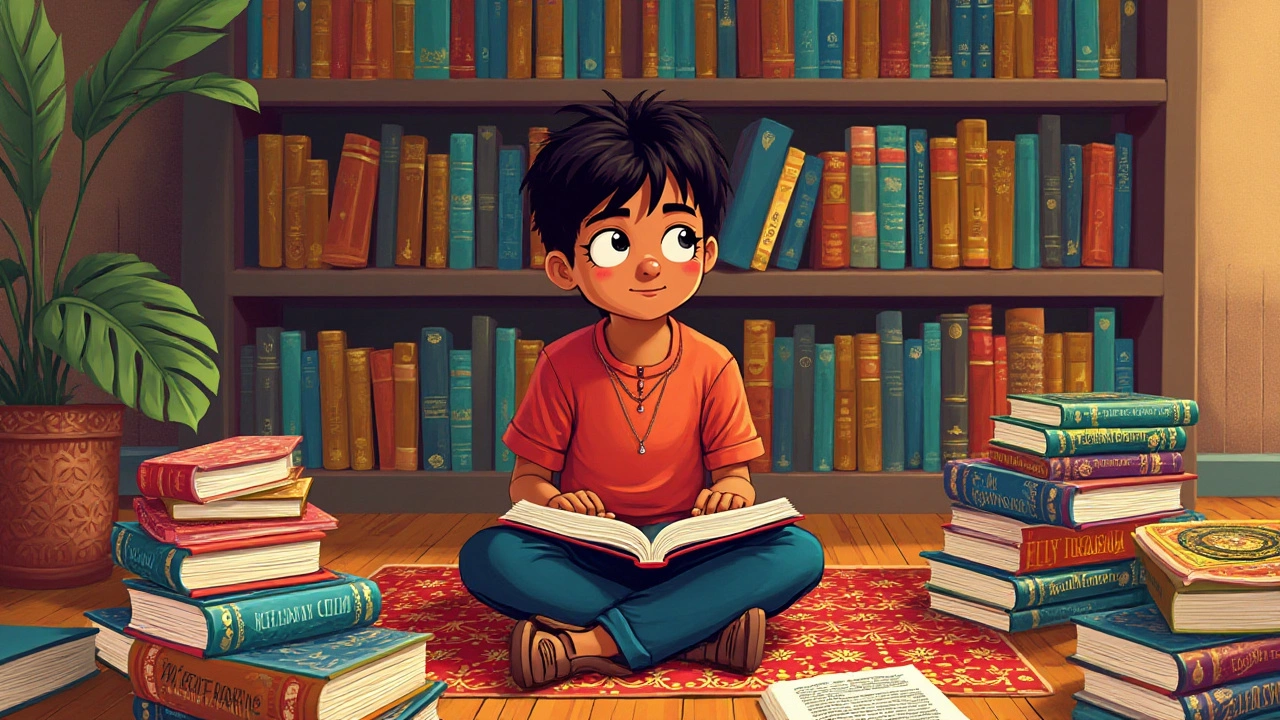Identifying Young Adult vs Adult Books: A Comprehensive Guide
 Jan, 26 2025
Jan, 26 2025
Books are an ocean of stories waiting to be explored, but distinguishing between young adult (YA) and adult novels can sometimes feel like navigating through murky waters. While the covers and blurbs might seem suggestive, the true heart of identifying a book’s intended audience often lies beyond the surface.
For readers, writers, and publishers, understanding these distinctions is crucial. It not only affects how books are marketed, but it also shapes the experiences of readers who step into these worlds. The key factors usually boil down to themes, writing styles, and character development, each providing valuable clues.
In this article, we'll unravel the nuanced differences between YA and adult books, offering insights and tips to enhance your literary radar. Whether you're a fan, an aspiring writer, or just curious about the intricacies of fiction categories, this guide is tailored for you.
- Understanding Themes and Topics
- Character Age and Development
- Writing Style and Language
- Target Audience and Marketing
Understanding Themes and Topics
In distinguishing between YA fiction and adult books, one of the most telling aspects lies in their themes and topics. Young adult novels often revolve around the experiences of adolescence and deal with issues that resonate deeply with young adult readers such as identity, first love, friendship, school life, and the journey to self-discovery. These themes are designed to mirror the transitional phases that adolescents undergo, providing both a mirror and a window into their own world. These stories often feature protagonists who are navigating the complexities of growing up, forming the core around which the narrative unfolds. For instance, Suzanne Collins's "The Hunger Games" explores themes of survival and societal issues through the perspective of a teenage protagonist, making it relatable to the YA audience.
Adult literature, on the other hand, often delves into more complex and mature subjects. It explores adult themes such as individuality, relationships, societal norms, and existential questions that require a deeper level of understanding and can be more nuanced in their exploration. Adult books do not shy away from intricate social and political issues, moral dilemmas, or the grey nuances of life, often incorporating these into their core narrative. This difference in thematic exploration is not merely to cater to different age groups but reflects the varied life experiences and perspectives that come with age. The protagonist in an adult book might tackle the challenges of marriage, career ambitions, or mid-life crises, topics that require an adult frame of mind to fully appreciate and resonate with.
Common Themes in Young Adult Fiction
The themes prevalent in YA fiction are not just limited to the well-trodden paths of adolescent life; they also touch upon complex issues like mental health, identity exploration along diverse spectrums, and the fight for justice and freedom. These themes are often presented in a manner that is accessible and relatable to younger audiences. For example, novels that address mental health, such as "All the Bright Places" by Jennifer Niven, introduce these topics with sensitivity and clarity, helping young readers better understand and process their own feelings and experiences. These books often aim to be both enlightening and comforting, giving young readers examples or role models during their formative years.
"The real voyage of discovery consists not in seeking new landscapes, but in having new eyes." – Marcel Proust
In exploring these themes, YA books frequently employ a sense of immediacy and intimacy. This creates a feeling of being in the moment with the character, experiencing the emotions as they come, which is a distinctly youthful perspective. These books often highlight growth and personal development; they are character-driven narratives that allow young readers to connect with their own processes of growth through the characters' journeys.
Nuanced Themes in Adult Books
For adult books, the range of themes can often be wider and more complex. Their focus can be intensely individualistic or expansively global, tying personal stories with larger societal narratives. Adult fiction might delve into themes such as financial hardship, long-term love, betrayal, power, or enduring past traumas. A brilliant example of such exploration is found in "Atonement" by Ian McEwan, where complex themes of guilt, love, and the consequences of actions ripple through the characters' lives and fuel the novel's narrative. The treatment of stories in adult literature often involves a layered narrative structure, where deeper truths about human nature and society are slowly unraveled. These books tend to challenge readers to think critically and reflect on their own experiences and beliefs, demanding an engagement that goes beyond the surface of the text.
Understanding these thematic distinctions is crucial for both readers and writers. It positions YA and adult novels as distinct genres, each with its own cherished purpose and audience. By recognizing the themes and topics, one gains valuable insight into the intended reader experience and the deeper messages the book seeks to convey. As such, whether you are choosing your next read or penning your manuscript, considering the themes and topics is an indispensable step in the journey.

Character Age and Development
The age of protagonists is often the first clue in distinguishing whether a book falls under the YA fiction or adult category. Typically, young adult novels feature characters between the ages of 12 and 18, echoing the experiences, challenges, and changes unique to this age group. These characters navigate the tumultuous journey of adolescence, and their experiences reflect issues like identity, belonging, and self-discovery. The stakes are high, and emotions run deep, making the teenage perspective uniquely vibrant and compelling. The boundary of age, however, isn't merely a number but a gateway into the developmental arcs these characters undergo, shaping the narrative direction and depth.
What's particularly fascinating about young adult novels is how they capture the essence of growth. Teen characters are frequently portrayed amid transformative experiences that accelerate their emotional and moral development. Whether it's grappling with difficult family dynamics, forging new relationships, or questioning societal norms, these plotlines parallel the intense growth periods that many real-life teens encounter. Writing in the 'Washington Post,' respected author John Green once noted,
"The characteristic quality of YA is not a specific subject, but a sense of urgency in the coming of age, finding a place in the world, and the interior life of teens."Such an urgency resonates with readers of all ages, rendering these narratives timeless.
In contrast, adult books may feature protagonists of any age but often include characters who have reached or are navigating post-adolescence stages. Their concerns and conflicts generally reflect more matured responsibilities like careers, family, long-term relationships, and existential dilemmas. Character development is frequently influenced by complex layers, examining how past experiences and current choices intertwine. Adult literature often dives deeply into nuanced character studies, where motivations and flaws are intricately tied to the narrative's core. These characters might not always resolve their internal conflicts, reflecting the sometimes indefinite nature of adulthood. The development arc in adult fiction stretches beyond simple resolution and ventures into the realm of ongoing personal evolution.
Addressing the developmental differences, one can discern that the lives of young adults are in a state of flux—ever-changing and dynamic. This fluidity shapes the narrative style, often resulting in fast-paced, emotionally driven novels. Conversely, adult literature may embrace a more measured, introspective approach, contemplating life's broader implications. Comparing character development across these genres offers valuable insights into the thematic focus and intended impact. A study by the American Library Association in 2019 highlighted that about 55% of YA readers are adults, indicating that the vigorous exploration of formative years in YA fiction appeals to readers beyond the traditional age demographic.
Understanding these developmental nuances not only aids in identifying the genre but enriches one's appreciation of the literary artistry involved. As characters evolve, whether bathed in the youthful light of adolescence or cast under the shadow of adulthood's complexity, their stories become windows into our shared human experience. This fundamental distinction is a lens through which we view the world—whether with the fervent hopefulness of youth or through the reflective wisdom gained with age.

Writing Style and Language
The delicate nuances of writing style and language often serve as the underpinning elements that distinguish YA fiction from adult novels. When we consider young adult books, one of the primary characteristics is the straightforward and accessible language. This choice ensures the story is easily digestible for a teenage audience, who are often just beginning to explore more complex narratives. However, this simplicity doesn't imply a lack of sophistication or depth; it's often more about clarity and directness. Adult books might embrace more complex sentence structures, broader vocabulary, and intricate prose that often requires a mature level of comprehension.
Beyond language complexity, the narrative voice in young adult novels typically mirrors the perspectives and experiences of adolescent characters. This tends to cultivate a sense of immediacy and intimacy, pulling the reader into the protagonist's world. In comparison, adult novels often explore multiple perspectives, offering a broader or more nuanced exploration of the themes. The stylistic differences also extend to dialogues and inner monologues, with YA fiction often featuring more conversational and relatable tones. This is critical in effectively resonating with younger readers, who see reflections of their own dialogues and internal musings in the characters.
"A good YA book doesn't condescend to its readers; it challenges them through empathy and emotional truth," says renowned YA author John Green. This insight underscores another pivotal aspect of writing style in YA fiction. The narrative might dwell on rich descriptions or detailed world-building, yet it is continually anchored by an emotional core that resonates with teenagers' real-life experiences.
Moreover, the pacing of the narrative and the structure itself can reflect divergent approaches. Young adult novels often prioritize faster pacing and compelling hooks to maintain engagement, which is particularly important as younger audiences might have shorter attention spans. Conversely, adult literature sometimes offers a more meandering journey, inviting readers to savor the language or ponder deeper themes at a leisurely pace. Consider this: among several bestsellers, 41% of YA novels commonly employ first-person narratives, while a variety of adult novels lean more towards third-person or even experimental styles, enhancing the breadth of storytelling techniques.
From a stylistic perspective, genre can also play a crucial role. While both YA and adult books cross into numerous genres, the treatment within those genres can vary. Romantic subplots in young adult novels, for instance, are often clean and tender, reflecting youthful ideals and the innocence of first loves. In contrast, adult romances may delve into more complex and mature explorations of relationships. Similarly, when it comes to themes like dystopia or fantasy, YA often uses these settings as metaphors for personal growth and self-discovery, while adult books might tackle socio-political commentaries and more explicit critiques of societal structures.

Target Audience and Marketing
When it comes to pinning down the target audience for a YA fiction or adult book, the strategy hinges on understanding the psychology and interests of the intended readership. Young adult novels are predominantly tailored for readers between the ages of 12 and 18. This age group is at a critical stage where they are exploring their identity and the world around them, making themes of self-discovery, growth, and emotional complexity resonate deeply. To capture this demographic, marketers often appeal to the current zeitgeist, plugging into the latest trends in fashion, music, and pop culture that influence teenagers.
With adult books, the canvas is considerably broader. The audience stretches from young adults venturing into more complex themes to older readers seeking rich narrative intricacies. Marketing adult literature often involves highlighting sophisticated themes like existential dilemmas, intricate relationships, and complex moral questions. This aligns with the matured perspectives and life experiences of adult readers. Traditional media, book clubs, and literary festivals often become prime avenues for promoting adult books, whereas social media platforms dominated by younger audiences, such as TikTok, play a pivotal role in the distribution and visibility of YA novels.
A commonly recorded observation in the publishing industry suggests that the crossover readership is noteworthy. Many adults indulge in young adult novels for their straightforward storytelling and vibrant themes, while young adults often dabble in adult fiction to experience more mature content. This blurred line between demographics presents challenges and opportunities for publishers, who must craft marketing campaigns that can captivate both niche and broad audiences. A successful example of such a crossover book is J.K. Rowling’s "Harry Potter" series, which was marketed to both children and adults, achieving a universal appeal that few others have managed.
"Young adult isn’t just a demographic, it’s a mindset," says David Levithan, a well-known YA author, highlighting the emotional intelligence and courage often portrayed in YA literature.
Statistics from the literary world back the fact that the YA market is not just a stepping stone for teenage readers; it holds its ground as a thriving genre catering to diverse age brackets. A 2023 survey revealed that over 55% of YA book buyers are above 18 years old, underscoring the attraction that these stories hold across age groups. To tap into this burgeoning audience, marketing strategies need to weave relatable content with accessibility, embracing digital ad campaigns on platforms frequented by both young and older populations. Face-to-face interactions at conventions and author meet-and-greets also enrich the reader’s experience, fostering a community around the books that spans age boundaries.